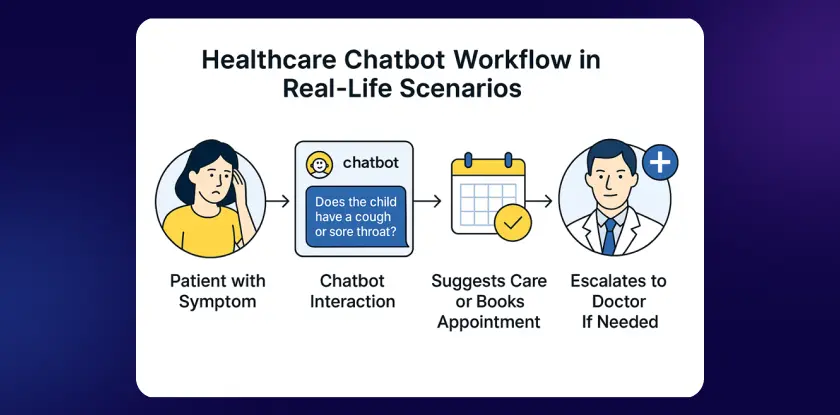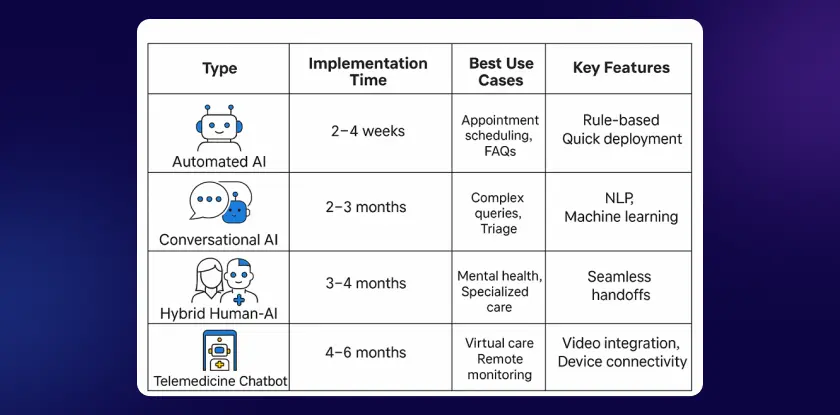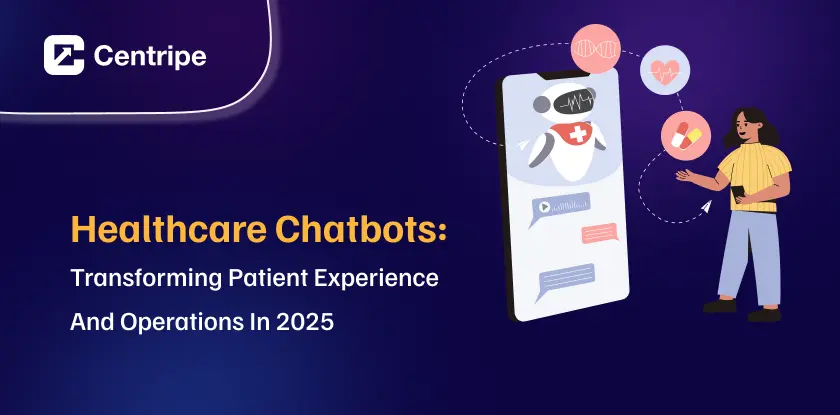Everything seems blurry when ‘health’ becomes the focus. That’s right in every sense. An emergency can arise anytime.
As a part of the most important requirement for humans, i.e., healthcare, you don’t want patients to wait in a long queue, just to get their symptoms analyzed.
Being a provider, you don’t want patients to be frustrated.
Here’s the thing: 74% of patients now expect digital communication from their healthcare providers.
Admin costs are eating everyone alive. AI Chatbot is finally delivering on its promise.
We are talking about $3.7 billion in annual savings across the industry, with these AI-powered helpers handling up to 90% of routine questions. That makes the work quite easy for them.
What Are Healthcare Chatbots? Understanding the Technology Reshaping Patient Communication
Healthcare chatbots understand medical stuff. They work like text messaging, but answer without limitation. They use vast resources to answer questions, which makes them reliable.
What they do:
- Answer basic health questions
- Help you find doctors or hospitals
- Remind you to take medicine
- Book doctor appointments
- Give first aid tips
- Check your symptoms
Examples:
- “What are the signs of flu?”
- “Find a dentist near me.”
- “Set a reminder for my blood pressure pill.”
These questions are answered instantly. So, they suggest first aid or any preventive measures based on the symptoms.
What makes them different from those awful phone trees we all hate? These modern systems pack:
Smart Understanding:
- They get what you mean, even if you don’t use exact words
- You can ask “My head hurts” instead of pressing 1 for headaches, 2 for migraines
- They understand normal language
Actually Helpful:
- Give you real answers, not just more menu options
- Learn from your questions to get better over time
- Can handle complex questions with multiple parts
Fast and Easy:
- No waiting on hold, listening to bad music
- No pressing 20 different buttons to get nowhere
- Get answers in seconds, not minutes
Personal Touch:
- Remember your past conversations
- Suggest things based on your specific needs
- Feel more like talking to a helpful person
Always Improving:
- Use smart technology (AI) to understand you better
- Keep learning new ways to help
- Actually solve problems instead of just transferring you

A parent sends a message about their child’s fever.
Your telemedicine chatbot steps in. It will ask the questions and deliver medical advice based on medical guidelines.
If necessary, it books the next available appointment.
All while ensuring everything stays HIPAA compliant and properly documented.
👉 Explore more articles: How to Use E-commerce Chatbot
Types of Healthcare Chatbots: Choosing the Right Solution for Your Organization

1. Automated AI Chatbots
Such a customer service chatbot handles simple, repetitive jobs. I am talking about booking appointments, prescription refills, and simple FAQs.
Best for: Small clinics, busy departments, or anyone who needs something fast and simple.
HIPAA? Usually, yes, if set up securely. Always check the vendor’s credentials.
2. Conversational AI Chatbots
They have real conversations with the patients, keep everything in their data, and even do sentiment analysis. They know what you asked previously and will relate those symptoms to the present ones.
Best for: Big hospitals, telemedicine, or anyone focused on improving the patient experience.
3. Hybrid Human-AI Chatbots
This is the best option for anyone wishing to deploy chatbots. The routine things are handled by AI, but sensitive or complex issues are transferred to human agents.
Best for: Specialist care, mental health, or places where a personal touch matters.
4. Specialized Telemedicine Chatbots
They are built for virtual healthcare such as video visits, monitoring devices, and other things you need, especially in remote areas.
Best for: Telehealth providers, remote patient monitoring programs, rural healthcare.
The Strategic Benefits of Healthcare Chatbots: ROI and Beyond
1. Cost savings and better efficiency
Healthcare chatbots help hospitals save money by cutting phone calls by 70%. They save $0.50 to $0.70 for each patient question they handle automatically.
These smart assistants remind patients about appointments, reducing missed visits by 30-40%. Staff gain 20-30% more time to help patients instead of answering simple questions.
2. Better Patient Access and Happiness
The advantage to the patient is they get health answers 24/7. No more holding time or getting transferred from one department to another.
They even chat in various languages. They help shy patients ask sensitive questions in private. This makes healthcare more comfortable and accessible for all.
3. Better health results through regular check-ups
Healthcare chatbots remind patients to take their medicine on time. This is very useful for those with chronic diseases like diabetes.
They do regular check-ins so health issues are caught early. Sending a reminder to patients about important tests, leading to fewer hospital visits.
4. Growing Without Extra Costs
A single chatbot can help thousands of patients at once. In contrast, human staff can assist only one person at a time. This enables hospitals to serve more patients without needing extra staff.
As hospitals grow, chatbots can easily add new services or languages. This doesn’t require extra training costs. Every patient gets the same excellent care, whether they are the first or the ten-thousandth of the day.
12 High-Impact Use Cases for Healthcare Chatbots
1. Intelligent Appointment Management
Q: How do healthcare chatbots handle appointment scheduling?
Ans: They check availability in real-time. They suggest alternatives based on urgency. They send reminders using the patients’ preferred channels.
They also handle rescheduling without any back-and-forth. They plug right into Epic, Cerner, or whatever you’re using.
Pro tip: Start with your busiest departments. Primary care and dermatology usually see the biggest wins right out of the gate.
2. Aligned Patient Onboarding
First impressions matter, right? Make onboarding smooth as butter: Collect info conversationally (way less painful than those 10-page forms), verify insurance eligibility on the spot, walk patients through what to expect, even help them figure out parking.
Real talk: The best organizations I’ve worked with cut their onboarding time in half. In. Half.
3. Local Healthcare Resource Navigation
Help patients find what they need, when they need it: Nearest in-network pharmacy, real-time ER wait times (absolute game-changer), transportation options for appointments, COVID testing sites, flu shot locations, you name it.
We’re losing $100 billion annually because people forget their meds. Let’s fix that: Smart refill reminders based on when they actually picked up their last prescription, drug interaction warnings in plain English, family vaccination schedules that sync with everyone’s calendar, and direct pharmacy integration so refills are one click away.
4. Pre-Appointment Preparation Support
Q: What information can chatbots provide before appointments?
A: They explain procedures in human language (not medical-ese), provide fasting instructions that people actually follow, answer the “what should I expect?” questions, and make sure all the paperwork’s done before they walk in the door.
5. Instant Healthcare Professional Connection
Sometimes you just need a human—telemedicine chatbots make it seamless: Smart symptom triage using validated protocols (not Dr. Google), book video consults without leaving the chat, escalate the urgent stuff immediately, pass along all the context so patients don’t repeat themselves.
6 Insurance Navigation and Claims Support
Because let’s face it, nobody understands insurance: “Is this covered?” answered instantly, out-of-pocket estimates that don’t require an MBA to understand, step-by-step claims submission help, and status tracking without playing phone tag.
7. Post-Diagnosis Education and Support
Knowledge is power, especially after getting diagnosed: Condition-specific info that’s actually helpful (not terrifying), connect with support groups and resources, track progress in ways that motivate, lifestyle tips that people can actually stick to.
8. Automated Patient Feedback Collection
Turn feedback into fuel for improvement: Ask for input when it’s fresh in their minds, spot issues before they become complaints, route problems to the right people instantly, and watch those satisfaction scores climb.
9. Chronic Disease Management Workflows
Long-term conditions need long-term support via sales chatbot solutions: Daily check-ins that take 30 seconds, not 30 minutes, medication reminders that actually work, goal tracking that keeps people motivated, and early warning systems that alert providers to issues.
10. Medical Records Access and Management
Put patients in control of their own data: Test results without the anxiety-inducing wait, easy record transfers between providers, vaccination records for travel or school, and update their info without calling three departments.
11. Personalized Patient Engagement
Build lasting relationships:
- Send birthday wishes (a small touch, a big impact).
- Share wellness tips tailored to their health history.
- Remind them about flu shots and check-ups each season.
12. Population Health Campaigns
Scale your outreach without scaling your staff: Target the right screening reminders to the right people, public health alerts that people actually see, coordinate vaccine drives efficiently, and share timely warnings about outbreaks or recalls.
Case Study: . UCHealth’s Chatbot
Company: UCHealth (University of Colorado Health), a large, reputable U.S. healthcare system.
Implementation & Functionality:
They integrated an AI-powered healthcare chatbot into UCHealth’s digital ecosystem.
It started by answering simple patient questions. Then, it grew into an important channel for patient engagement and service.
The AI now provides:
- Personalized health information.
- Test results delivery.
- Support with appointment scheduling.
- Doctor-patient messaging integration.
Source: Kommunicate blog (2025).
Common Problems and Solutions
Problem 1: Keeping Medical Information Accurate
Healthcare chatbots stay accurate by having real doctors check their answers. They also set up safety rules. When unsure, they send questions to humans.
How to get it right:
- Involve doctors early.
- Set up safety checks.
- Let the chatbot say, “I don’t know” when needed.
- Review everything regularly.
Problem 2: Protecting Patient Privacy
Safety essentials:
- Lock all patient data with strong security.
- Have everyone sign privacy agreements.
- Test security regularly.
- Document everything.
Patient trust is everything. When people feel their health information is safe, they use chatbots more. They also share important details for better care.
Problem 3: Setting Clear Expectations
Be clear about what your chatbot can and can’t do. Make it easy to reach real people when needed. Explain limits upfront and keep patients updated on new features.
Clear expectations make patients happier and more likely to use the service again.
Problem 4: Preventing Wrong Information
Only let chatbots handle tested topics, set up safety checks for medical info, test unusual questions, and monitor quality constantly.
Safety first – have humans double-check important medical information to keep patients safe.
Future Trends (2025-2030)
Smart Emotional Understanding
Next-gen chatbots will know when you feel worried or scared. They will respond with true empathy and support.
Predicting Health Problems
Chatbots can find health issues early, even before symptoms show. This helps avoid bigger problems down the line.
Easy Communication Switching
Easily switch between typing, voice, video calls, and virtual reality – all in one chat.
Personal Health Control
You will own your health records. Chatbots can access them safely to provide personalised care.
Simple Implementation Steps
Step 1: Set Clear Goals
Pick 3-5 main objectives. Set measurable targets with numbers. Know your starting point to prove success.
Step 2: Choose the Right Technology
The healthcare platform should be like Centripe.ai, which protects patients’ data and integrates easily with your existing systems.
Step 3: Design Helpful Conversations
Chart real patient journeys. Gather clinical input early. Test with real patients, not just tech teams.
Step 4: Start Small
Start with quick wins. Get feedback early. Improve fast. Scale what works and stop what doesn’t.
Step 5: Track and Improve
Measure everything important. Use conversation data to improve. Then, expand carefully based on proven success.
👉 Want to learn more? Check out this related blog:
Chatbot Analytics: Essential Performance Metrics Guide
Conclusion
Healthcare is the priority for everyone! These AI healthcare chatbots are nothing short of a blessing.
They take care of the patients’ info, communicate with them, make them feel relaxed, understand their symptoms, provide them with preventive measures, and so on.
No doubt human agents and attendees are required at certain instances, but are everyone equipped with the versatility of chatbots? No.
They can talk in various languages, grasp the intent of patients, and send them reminders about their appointments without missing out. So, overall, healthcare is on revolutionary terms with these chatbots.
